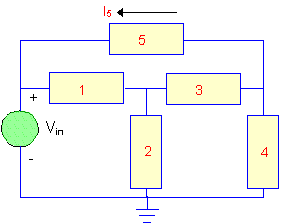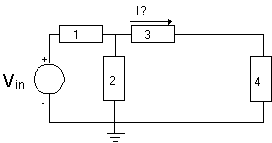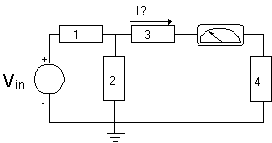| Current |
Facts About Current - Units
There
is one last point you need to know.
-
Current - like every other
physical variable - has units. Current is really charge flow, so the units
for current are in terms of charge/time. In the MKS system that is: Current units =
charge/time = couloumbs/sec = amperes.
The
most commonly used unit it the ampere, and it is
often referred to as amps. If we have a
current of 3.5 amperes, we would say:
I = 3.5 amp or I = 3.5A
Facts About Current - Polarity
When you have a circuit and you want to figure out how the circuit will behave
you will generally try to determine what the currents and voltages in the
circuit are going to be. That prediction is what you want. However,
before you can calculate a current you need to have a precise definition of what
you mean by the current, and that's where you get involved with polarity.
We will introduce the idea of polarity with a question for you to answer.
Question
Q1 .
In this circuit, Willy Nilly wants to determine current I5.
He has defined that current as shown below at the left. Is that the
correct definition of the current? Or is the current definition at the
right the correct one? (Note, depending on visual space in your browser,
the right one may display below the left one so the buttons are labelled
Left/Top and Right/Bottom.)
  
The point
to the question above, is that when you are analyzing a circuit, the way current
polarity is defined is entirely up to the person who is analyzing the circuit.
(That's unless your instructor asks you to use a particular polarity, or a
textbook problem defines the polarity for you.) Polarity definitions are
arbitrary. Make sure that you always are clear about how you define
polarity - both for current and for voltage. Otherwise, you may work a
problem and find I5
= 7A, and someone else may find -7A. You could have a long argument only
to find out that you and the other person defined polarities differently.
Facts About
Current - Summary
Let's
review things a bit.
-
Like water flowing in a pipe,
current flows in a wire. Just as the water in the pipe is confined to the
pipe, the charge flowing in a wire is confined to the wire. It can't get
away, and stays within the wire surface.
-
Like water flowing in a pipe,
charge has to go somewhere. So, in fact, it flows through electrical
devices, going in one terminal and out another.
-
When current flows for a time
charge flows. Current is the rate of flow of charge, so you can determine
how much charge flows from the current and the time it flows when the current is
constant.
Measuring Current
Current
flows through something. Current can flow through a wire, the normal
situation, but it can also flow through an ionic solution, through the ground,
and many other things. The important word here is through.
Current is a through variable.
Current always flows through something.
What this means is that in order to measure current you
need to get the current to go through a meter. An ammeter is the
type of meter used to measure current. In this section we'll talk about
measurement of current and using ammeters.
Here's a diagram of a circuit with an ammeter inserted to measure a current.
There are many different currents flowing in this circuit. We are
interested in current I?, which flows through element 3. We want to
measure current I?. (We call it I? because that's the one we want to
know.)

Now, if
we want to measure that current, we have to get it to flow through through an
ammeter - a device that measures current. The way we do that is to break
the circuit between element 3 and element 4 and insert an ammeter in series with
element 3. We say that two elements are in series whenever the current
that goes through one element is forced to go through a second element.
Note that all of the current going through the first element (element 3 here)
goes through the second element (the ammeter here). Here's a circuit
diagram that shows where the ammeter goes.

The
important thing here is to see how the ammeter is inserted so that the current
you want to measure is made to flow through the ammeter. When that current
flows, the ammeter will measure the current. Here, current I? flows
through the ammeter after flowing through element 3 and before flowing into
element 4.
Here's a pictorial representation of an analog ammeter. It's typical of
ammeters. It has two terminals. They are usually red and black.
When you have one red terminal and one black terminal, you can be sure that the
ammeter will read a current like the one defined in the picture. When the
current, I, shown in the figure, is positive, then the ammeter needle will read
upscale indicating the measured current.

Now,
here's a representation of a digital ammeter. It's going to have the same
kind of terminals. The difference here is that it will give a digital
value for the measurement, showing the measurement result with an LED display.

There's
nothing very complicated about measuring current. You need to get the
current you want to measure to flow through an ammeter which will then measure
the current. In principle it's pretty simple.
Problem
10. Here is the same circuit where we introduced you to the ammeter. We kept
the ammeter in the same place.

We placed the ammeter there
in order to measure the current through element 3.
-
Does the ammeter also measure
the current through element 4?
-
Does the ammeter also measure
the current through element 1?
A Note On The Discrete Nature Of Charge
There's one other item to consider. Charge comes in discrete packets but
it is often useful to assume that it can take on continuous values. That
lets us bring all the power of calculus to bear when we discuss current. Current
is the flow of charge, and it is thought of in terms of a quantity of charge
flowing through an area in some small amount of time. However, we often
want to drive that concept to the limit, by imagining a current at an instant.
Then, we imagine letting the time interval shrink to zero so that we think of
current as a derivative:
i(t) = dQ(t)/dt
We do realize through all of this that charge comes in discrete packets, and
that this limit is ultimately mathematical nonsense. Still, the charge of
an electron is so small that we can think in these terms in most practical
situations. When we consider more complex circuits it will be helpful if
we think, however, in terms of charge that can take on continuous values.
Using Current -
Where Do You Use Current?
You
use current every time you use an electrical appliance of any sort.
-
If you own a car, you own a
storage battery. The battery stores enough energy to allow you to start
your car. The battery stores energy by storing charge on the battery plates.
When you use the battery, charge flows out of the battery. That's current
flowing from the battery.
-
When you plug an electrical
device into a wall plug you use current. One example is a light bulb.
Current flows from the wall plug, through the connecting wire and through the
bulb. In the process, the current heats up the filament in the bulb
generating light - unless it is a fluorescent lamp, and then a different process
creates the light.
What if the Current isn't Electrons in a Wire?
The
most common kind of current you will see will be electrons flowing in a wire.
That's what you'll see 99% of the time. However, any time any form of
charge flows, that's a current.
Here are a few examples of currents. Current - a flow of charge - is what
happens when you have any of the following, and it is not an exclusive list!
-
Ions in motion in water - What
would happen if you managed to connect an electrical outlet to a sink full of
water. Ions, however, also move in car batteries and electroplating
solutions.
-
Charged blobs of ink in an
ink-jet printer.
-
Electrons moving through space
- For example, the electrons striking the computer screen to generate the
picture seen as this is written on a computer.
|

